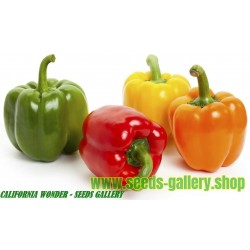Sweet Pepper Seeds California Wonder
Price for Package of 20 or 100 seeds.
HEIRLOOM. The standard bell
pepper for many decades, this 1928 introduction is still the largest open-pollinated,
heirloom bell you can grow, and a big improvement over the earlier bells. A perfect stuffing
pepper—blocky 4" x 3 1/2", thick-walled, tender and flavorful.
Detailed planting instructions:
Sow seeds indoors, 1/4 inch deep in flats, peat pots or cellpacks, 8-10 weeks before you anticipate transplanting outside. Seed germinates best when soil temperature is 80 F or higher. It will not germinate below 55 F.
Keep plants indoors in a warm (70 F during the day, 65 F at night), sunny location. Lack of light will produce leggy, unproductive transplants.
Don't be in a rush to transplant outside. Cold temperatures can weaken plants and they may never fully recover. A few days at 60 F to 65 F with reduced water will help harden plants and reduce transplant shock. Over-hardened plants grow slowly after transplanting.
Set plants out 2 to 3 weeks after average last frost when the soil has warmed and the weather has settled. Plant them 12 to 24 inches apart, in rows 24 to 36 inches apart, or spaced about 14 to 16 inches apart in raised beds.
Use black plastic and/or row covers to speed soil warming and early growth. Use caution with row covers not to overheat plants and cause them to drop their blossoms.
If not using black plastic, mulch plants after they are well established and the soil has warmed to retain moisture and control weeds.
Peppers can be temperamental when it comes to setting fruit if temperatures are too hot or too cool. Nighttime temperatures below 60 F or above 75 F can reduce fruit set.
Too much nitrogen fertilizer may promote lush vegetative growth but fewer fruits.
Peppers usually responds well to phosphorus fertilizer.
Stake tall varieties for earlier and heavier harvest.
Peppers need even moisture for best performance. An even supply can reduce blossom end rot, a disorder caused by lack of calcium.
Do not plant in same spot more than once every 4 years.
HARVESTING
Make sure the bell
peppers are firm and shiny with a crisp texture. Use garden shears to clip the fruits from the plant instead of pulling them off.
Pick bell
peppers when they are smaller in the beginning of summer. They may be taken when they are the size of a golf ball and frequent picking will encourage near-continuous fruit production. Immature bell
peppers are soft and pliable with thin pale walls.
Take fully mature bell
peppers when they are four to five inches long and have full, well-formed lobes. The older the fruit is, the thicker the skin will be.
Allow the bell
peppers to ripen to their final color later in the season to get fruit of different colors. Ripe bell
peppers may be yellow, red, orange or purple, depending on the variety. You can continue to harvest bell
peppers until the first frost.
Store bell
peppers at 50 degrees and at least 90 percent humidity, if possible. They should be stored away from other fruits and
vegetables because they are sensitive to ethylene gas, which causes them to age faster.
SAVING SEEDS
Cut your favorite variety of
pepper in half. All of the seeds inside are most likely viable and you can use them to grow the same variety of
pepper in containers or in a sunny garden spot. Collect the seeds and lay them flat on a paper towel for 24 hours.
Label the plastic bag with the permanent marker with the name or variety of the
pepper seeds. Place the seeds inside for planting.
Keep the seeds in a cool, but not cold, dark area until you are ready to start them in early spring.






 Reviews (0)
Reviews (0)